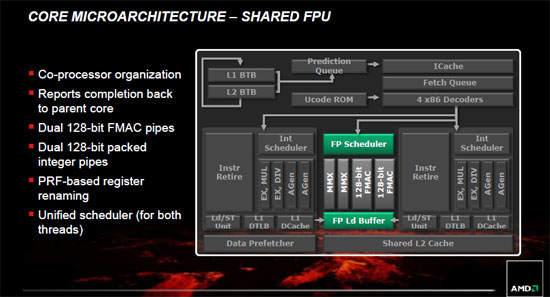AMD Trinity A10-4600M Laptop APU Review – Piledriver Arrives
Piledriver Cores, Turbo Core 3.0 & GPU-Z Shots

The AMD Trinity APU is based on the latest and greatest core from AMD, the ‘Piledriver’ core. If y ou have been following the progression of AMD’s x86 cores for the last year, you may recognize this layout from the AMD FX ‘Bulldozer’ processors.

The above image has been borrowed from the AMD FX-8150 ‘Bulldozer’ article from last October. If you compare the two images above, you can see a very distinct similarity. This is a huge difference in the technology between the A8 APU’s and the new A10 APU’s that we are looking at today. The A8 ‘Llano’ APU features up to four 32nm x86 Stars cores, the AMD ‘Trinity’ A10 APU features 1-2 Piledriver modules. Each of the Piledriver modules is seen as two cores to the operating system essentially giving Trinity the options of a dual core processor or a quad core processor depending on the configuration used. Unfortunately the AMD FX ‘Bulldozer’ product stack wasn’t as well received as AMD had hoped so AMD took to the drawing board and did a bit of tweaking. The core architecture of the AMD Piledriver remains unchanged.

While the core architecture is unchanged, AMD went in and tweaked, modified, and re-engineered many of the components of the core to improve them make them much more efficient. When comparing the 32nm Piledriver core to the previous generation Bulldozer core, there are a number of enhancements which include IPC (Instructions per Clock) improvement, Leakage reduction, CAC reductions, and a frequency uplift.

When the flagship APU, the AMD Llano A8-3850 APU was first introduced it did not feature AMD’s Turbo Core technology. Further along in the Llano lifespan AMD did release a couple of 65 Watt TDP parts that featured the Turbo Core Technology. The 65 Watt TDP parts that had the Turbo Core available would only see an increase in the x86 cores of the chip. The entire GPU side was left out of the equation. AMD has now introduced an improved version of the Turbo Core Technology! Turbo Core Technology 3.0 will boost the performance of the x86 ‘Piledriver’ cores as well as the GPU side of the APU! In the Trinity APU, the GPU can exceed it’s maximum frequency when under a heavy load if the CPU cores aren’t hitting their TDP limit. If the CPU cores are under a heavy load and the GPU has unused TDP, it can be reallocated to the CPU cores and we will see a boost to the frequency.
On the AMD A10-4600M APU the GPU scales from a base clock of 496MHz to 685MHz under heavy 3D rendering requirements and the CPU scales from a base clock of 2.3GHz all the way up to 3.2GHz in some single-threaded applications.

At an idle the AMD A10-4600M APU would be around 1400MHz and according to CPU-Z the processor was needing just 0.275 Volts of power! This is impressive!

When we ran benchmarks on the AMD A10-4600M APU, we mostly saw the processor running around 2700MHz with 0.800 Volts.

In some single threaded applications we were able to see the AMD A10-4600M APU reach 3200MHz, but it wasn’t for long. The APU was using 1.025 Volts at it’s maximum Turbo speed!

Comments are closed.